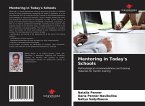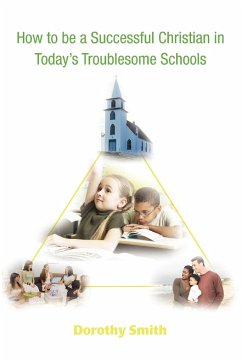- Broschiertes Buch
- Merkliste
- Auf die Merkliste
- Bewerten Bewerten
- Teilen
- Produkt teilen
- Produkterinnerung
- Produkterinnerung
Now more than ever before, parents need to be informed so that they may become active, knowledgeable partners in the educational process. Here, the authors discuss contemporary educational issues of paramount concern for parents.
Andere Kunden interessierten sich auch für
![Hot-Button Issues for Teachers Hot-Button Issues for Teachers]() Philip D. VairoHot-Button Issues for Teachers61,99 €
Philip D. VairoHot-Button Issues for Teachers61,99 €![Privileged Thinking in Today's Schools Privileged Thinking in Today's Schools]() David BarnettPrivileged Thinking in Today's Schools94,99 €
David BarnettPrivileged Thinking in Today's Schools94,99 €![Privileged Thinking in Today's Schools Privileged Thinking in Today's Schools]() David BarnettPrivileged Thinking in Today's Schools40,99 €
David BarnettPrivileged Thinking in Today's Schools40,99 €![The Struggle for Identity in Today's Schools The Struggle for Identity in Today's Schools]() The Struggle for Identity in Today's Schools159,99 €
The Struggle for Identity in Today's Schools159,99 €![The Struggle for Identity in Today's Schools The Struggle for Identity in Today's Schools]() The Struggle for Identity in Today's Schools64,99 €
The Struggle for Identity in Today's Schools64,99 €![Mentoring in Today's Schools Mentoring in Today's Schools]() Natalia PennerMentoring in Today's Schools17,99 €
Natalia PennerMentoring in Today's Schools17,99 €![How to Be a Successful Christian in Today's Troublesome Schools How to Be a Successful Christian in Today's Troublesome Schools]() Dorothy SmithHow to Be a Successful Christian in Today's Troublesome Schools12,99 €
Dorothy SmithHow to Be a Successful Christian in Today's Troublesome Schools12,99 €-
-
-
Now more than ever before, parents need to be informed so that they may become active, knowledgeable partners in the educational process. Here, the authors discuss contemporary educational issues of paramount concern for parents.
Hinweis: Dieser Artikel kann nur an eine deutsche Lieferadresse ausgeliefert werden.
Hinweis: Dieser Artikel kann nur an eine deutsche Lieferadresse ausgeliefert werden.
Produktdetails
- Produktdetails
- Verlag: Globe Pequot Publishing Group Inc/Bloomsbury
- Seitenzahl: 192
- Erscheinungstermin: 5. April 2006
- Englisch
- Abmessung: 229mm x 152mm x 11mm
- Gewicht: 287g
- ISBN-13: 9781578864256
- ISBN-10: 1578864259
- Artikelnr.: 25417155
- Herstellerkennzeichnung
- Libri GmbH
- Europaallee 1
- 36244 Bad Hersfeld
- gpsr@libri.de
- Verlag: Globe Pequot Publishing Group Inc/Bloomsbury
- Seitenzahl: 192
- Erscheinungstermin: 5. April 2006
- Englisch
- Abmessung: 229mm x 152mm x 11mm
- Gewicht: 287g
- ISBN-13: 9781578864256
- ISBN-10: 1578864259
- Artikelnr.: 25417155
- Herstellerkennzeichnung
- Libri GmbH
- Europaallee 1
- 36244 Bad Hersfeld
- gpsr@libri.de
By Sheldon Marcus and Philip D. Vairo
Part 1 Preface: Who Wrote This Book and Why? Part 2 Introduction Part 3
Part I: The Teacher and the Principal Chapter 4 Are You Happy with Your
Child's Classroom Teacher? Chapter 5 Is Your Child's Principal a Real
Leader? Chapter 6 Male Teachers in the Primary Grades: Where are They?
Chapter 7 Should Parents Play a Role in the Selection, Promotion,
Compensation, and Dismissal of Teacher's and Principals? Part 8 Part II:
Classroom Management and Organization Chapter 9 Homogeneous versus
Heterogeneous Grouping: What Are Your Views? Chapter 10 Promotional
Policies: Where Do You Stand? Chapter 11 Classroom Discipline: What Kind Do
You Want for Your Child? Chapter 12 How Can Homework Be Utilized as an
Effective Learning Tool? Chapter 13 Children with Special Needs: Where Do
They Fit? Part 14 Part III: Curriculum and Textbook Issues Chapter 15 The
Three Rs and Rote Learning: Are They Outdated? Chapter 16 Bilingual
Education: What Does It Really Accomplish? Chapter 17 Is There a Place for
Diversity in the Curriculum? Chapter 18 Textbooks Used in Our Schools: Have
You Reviewed Them? Part 19 Part IV: Evaluation Chapter 20 Report Cards and
Standardized Tests: What Do They Tell You? Chapter 21 Can You Help Your
Child Who Is a "C" Student Become an "A" or "B" Student? Chapter 22
Parent-Teacher Conferences: What Is Your Plan? Part 23 Part V: Evolving
Issues Chapter 24 Nutrition and the School Cafeteria: How is Your School
Doing? Chapter 25 Sex, Drugs, Smoking, and Other Health Concerns: Do They
Belong in the School Curriculum? Chapter 26 What Can Be Done to Improve
School Safety and Avoid Violence in Our Schools? Chapter 27 College
Admission: Is It Ever Too Early to Plan for Your Child's Future? Part 28
Part VI: Alternative Strategies Chapter 29 School Vouchers: Problems or
Opportunities? Chapter 30 Homeschool Instruction: A New Era or an
Educational Error? Chapter 31 Summer School, After-School Activities, and
the Extended School Year: Are New Directions Needed? Chapter 32 Public,
Private, or Religious Schools: Which One for Your Child? Part 33 Concluding
Remarks Part 34 Supplementary Reading
Part I: The Teacher and the Principal Chapter 4 Are You Happy with Your
Child's Classroom Teacher? Chapter 5 Is Your Child's Principal a Real
Leader? Chapter 6 Male Teachers in the Primary Grades: Where are They?
Chapter 7 Should Parents Play a Role in the Selection, Promotion,
Compensation, and Dismissal of Teacher's and Principals? Part 8 Part II:
Classroom Management and Organization Chapter 9 Homogeneous versus
Heterogeneous Grouping: What Are Your Views? Chapter 10 Promotional
Policies: Where Do You Stand? Chapter 11 Classroom Discipline: What Kind Do
You Want for Your Child? Chapter 12 How Can Homework Be Utilized as an
Effective Learning Tool? Chapter 13 Children with Special Needs: Where Do
They Fit? Part 14 Part III: Curriculum and Textbook Issues Chapter 15 The
Three Rs and Rote Learning: Are They Outdated? Chapter 16 Bilingual
Education: What Does It Really Accomplish? Chapter 17 Is There a Place for
Diversity in the Curriculum? Chapter 18 Textbooks Used in Our Schools: Have
You Reviewed Them? Part 19 Part IV: Evaluation Chapter 20 Report Cards and
Standardized Tests: What Do They Tell You? Chapter 21 Can You Help Your
Child Who Is a "C" Student Become an "A" or "B" Student? Chapter 22
Parent-Teacher Conferences: What Is Your Plan? Part 23 Part V: Evolving
Issues Chapter 24 Nutrition and the School Cafeteria: How is Your School
Doing? Chapter 25 Sex, Drugs, Smoking, and Other Health Concerns: Do They
Belong in the School Curriculum? Chapter 26 What Can Be Done to Improve
School Safety and Avoid Violence in Our Schools? Chapter 27 College
Admission: Is It Ever Too Early to Plan for Your Child's Future? Part 28
Part VI: Alternative Strategies Chapter 29 School Vouchers: Problems or
Opportunities? Chapter 30 Homeschool Instruction: A New Era or an
Educational Error? Chapter 31 Summer School, After-School Activities, and
the Extended School Year: Are New Directions Needed? Chapter 32 Public,
Private, or Religious Schools: Which One for Your Child? Part 33 Concluding
Remarks Part 34 Supplementary Reading
Part 1 Preface: Who Wrote This Book and Why? Part 2 Introduction Part 3
Part I: The Teacher and the Principal Chapter 4 Are You Happy with Your
Child's Classroom Teacher? Chapter 5 Is Your Child's Principal a Real
Leader? Chapter 6 Male Teachers in the Primary Grades: Where are They?
Chapter 7 Should Parents Play a Role in the Selection, Promotion,
Compensation, and Dismissal of Teacher's and Principals? Part 8 Part II:
Classroom Management and Organization Chapter 9 Homogeneous versus
Heterogeneous Grouping: What Are Your Views? Chapter 10 Promotional
Policies: Where Do You Stand? Chapter 11 Classroom Discipline: What Kind Do
You Want for Your Child? Chapter 12 How Can Homework Be Utilized as an
Effective Learning Tool? Chapter 13 Children with Special Needs: Where Do
They Fit? Part 14 Part III: Curriculum and Textbook Issues Chapter 15 The
Three Rs and Rote Learning: Are They Outdated? Chapter 16 Bilingual
Education: What Does It Really Accomplish? Chapter 17 Is There a Place for
Diversity in the Curriculum? Chapter 18 Textbooks Used in Our Schools: Have
You Reviewed Them? Part 19 Part IV: Evaluation Chapter 20 Report Cards and
Standardized Tests: What Do They Tell You? Chapter 21 Can You Help Your
Child Who Is a "C" Student Become an "A" or "B" Student? Chapter 22
Parent-Teacher Conferences: What Is Your Plan? Part 23 Part V: Evolving
Issues Chapter 24 Nutrition and the School Cafeteria: How is Your School
Doing? Chapter 25 Sex, Drugs, Smoking, and Other Health Concerns: Do They
Belong in the School Curriculum? Chapter 26 What Can Be Done to Improve
School Safety and Avoid Violence in Our Schools? Chapter 27 College
Admission: Is It Ever Too Early to Plan for Your Child's Future? Part 28
Part VI: Alternative Strategies Chapter 29 School Vouchers: Problems or
Opportunities? Chapter 30 Homeschool Instruction: A New Era or an
Educational Error? Chapter 31 Summer School, After-School Activities, and
the Extended School Year: Are New Directions Needed? Chapter 32 Public,
Private, or Religious Schools: Which One for Your Child? Part 33 Concluding
Remarks Part 34 Supplementary Reading
Part I: The Teacher and the Principal Chapter 4 Are You Happy with Your
Child's Classroom Teacher? Chapter 5 Is Your Child's Principal a Real
Leader? Chapter 6 Male Teachers in the Primary Grades: Where are They?
Chapter 7 Should Parents Play a Role in the Selection, Promotion,
Compensation, and Dismissal of Teacher's and Principals? Part 8 Part II:
Classroom Management and Organization Chapter 9 Homogeneous versus
Heterogeneous Grouping: What Are Your Views? Chapter 10 Promotional
Policies: Where Do You Stand? Chapter 11 Classroom Discipline: What Kind Do
You Want for Your Child? Chapter 12 How Can Homework Be Utilized as an
Effective Learning Tool? Chapter 13 Children with Special Needs: Where Do
They Fit? Part 14 Part III: Curriculum and Textbook Issues Chapter 15 The
Three Rs and Rote Learning: Are They Outdated? Chapter 16 Bilingual
Education: What Does It Really Accomplish? Chapter 17 Is There a Place for
Diversity in the Curriculum? Chapter 18 Textbooks Used in Our Schools: Have
You Reviewed Them? Part 19 Part IV: Evaluation Chapter 20 Report Cards and
Standardized Tests: What Do They Tell You? Chapter 21 Can You Help Your
Child Who Is a "C" Student Become an "A" or "B" Student? Chapter 22
Parent-Teacher Conferences: What Is Your Plan? Part 23 Part V: Evolving
Issues Chapter 24 Nutrition and the School Cafeteria: How is Your School
Doing? Chapter 25 Sex, Drugs, Smoking, and Other Health Concerns: Do They
Belong in the School Curriculum? Chapter 26 What Can Be Done to Improve
School Safety and Avoid Violence in Our Schools? Chapter 27 College
Admission: Is It Ever Too Early to Plan for Your Child's Future? Part 28
Part VI: Alternative Strategies Chapter 29 School Vouchers: Problems or
Opportunities? Chapter 30 Homeschool Instruction: A New Era or an
Educational Error? Chapter 31 Summer School, After-School Activities, and
the Extended School Year: Are New Directions Needed? Chapter 32 Public,
Private, or Religious Schools: Which One for Your Child? Part 33 Concluding
Remarks Part 34 Supplementary Reading








